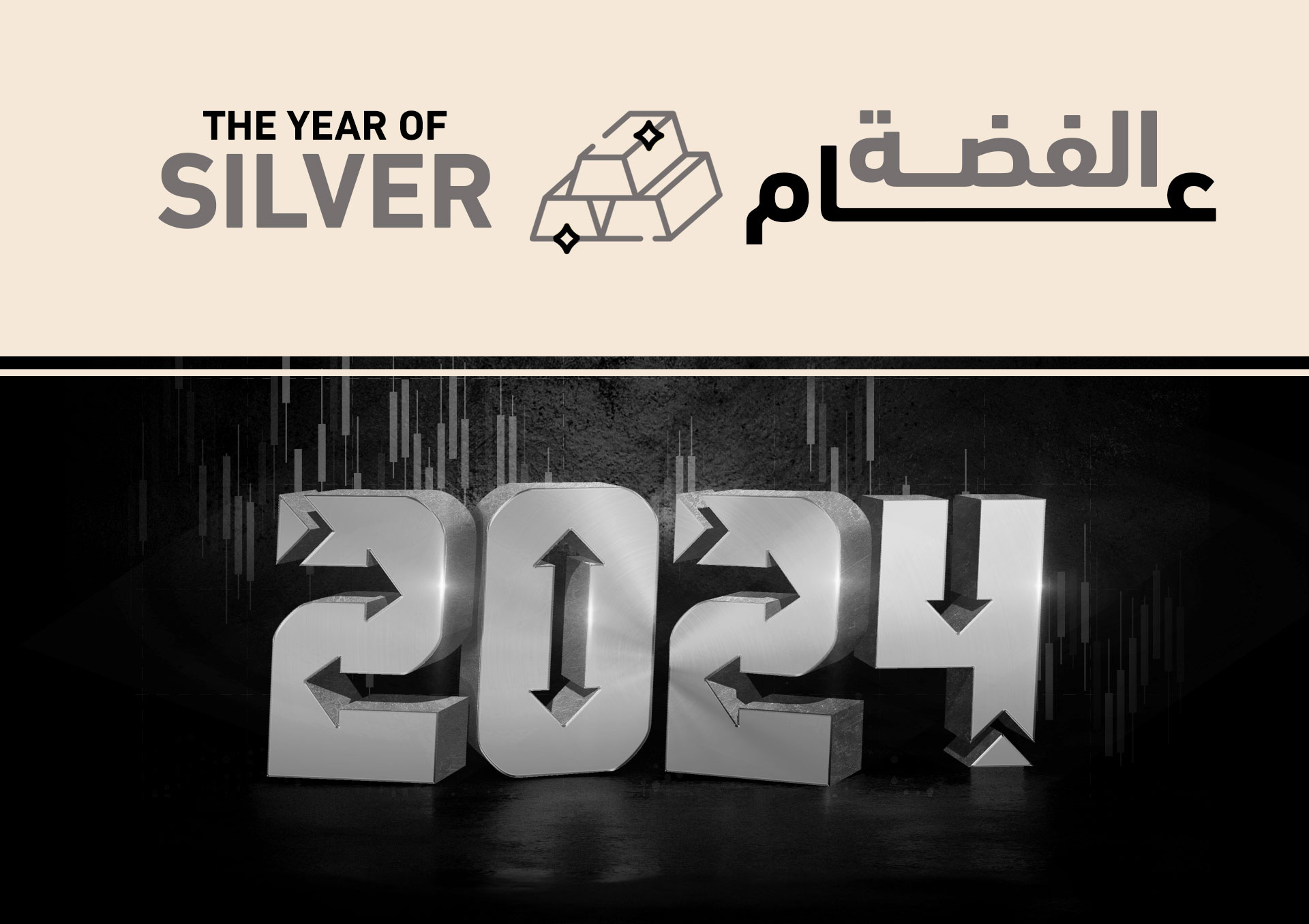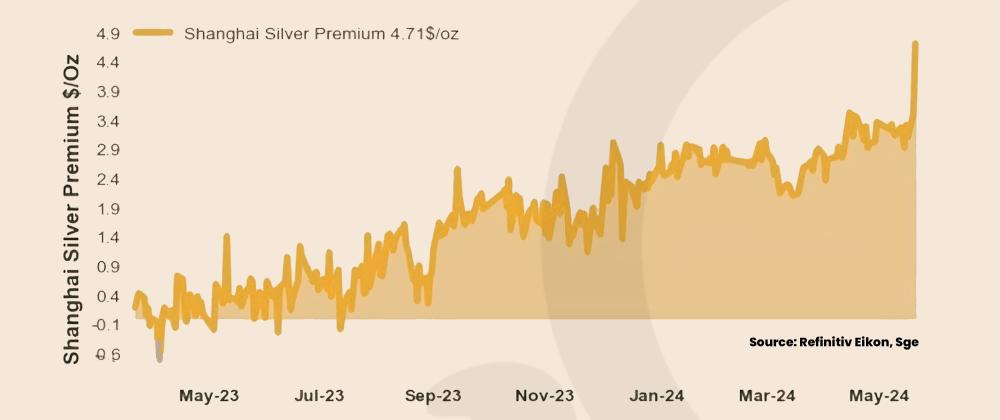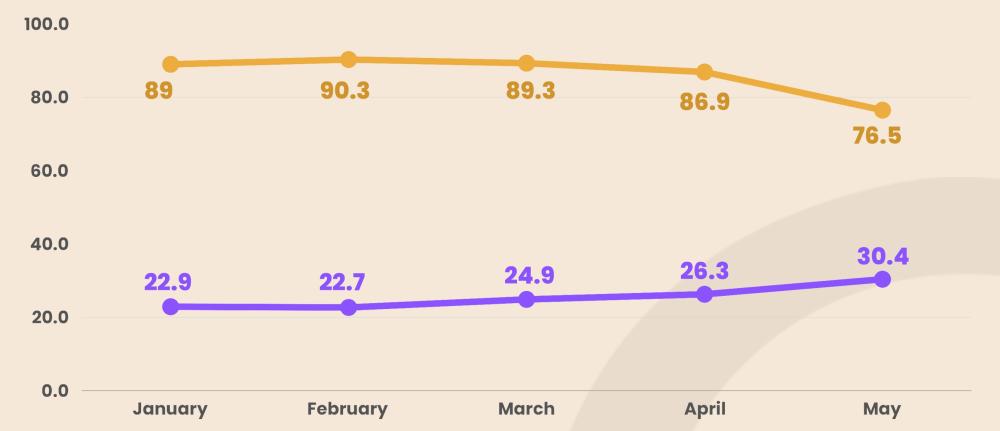أداء الفضة في 2024: العوامل المحركة والتوقعات المستقبلية
- Home
- Information Center by DahabMasr
- أداء الفضة في 2024: العوامل المحركة والتوقعات المستقبلية

أداء الفضة في 2024: العوامل المحركة والتوقعات المستقبلية
عام الذهب
.مع وصول المعدن الأبيض إلى 30 دولار للمرة الثانية خلال النصف الأول من عام 2024، انضمت الفضة إلى قائمة المعادن الأفضل أداءً هذا العام. لقد سجلت مستويات قياسية وتجاوزت مستوى 32 دولارًا للمرة الأولى منذ عام 2020 خلال تداولات 20 مايو، مع استمرار التوقعات الإيجابية للفترة المقبلة

ماذا وراء صعود الفضة؟
:يأتي صعود الفضة مدعوماً بعدة عوامل
.ارتفاع شهية المستثمرين-
.تحسن أداء الاقتصاد العالمي تدريجياً-
.تزايد الطلب على الألواح الشمسية، مما يدفع سوق الفضة إلى عجز محتمل في المعروض للعام الرابع على التوالي-
.تراجع مخزونات سبائك الفضة خلال شهر أبريل في بورصات لندن ونيويورك وشنغهاي إلى أدنى مستوياتها، حسبما أفادت بلومبرج-
الصين تغزو سوق الفضة العالمي

.تستمر أسعار الفضة في الصين في تحطيم الأرقام القياسية، حيث سجلت 36.2 دولار للأونصة مقابل 31.5 دولار في بورصة لندن، مما يحفز على شراء المزيد من المعدن من الأسواق ويؤثر سلباً على الإمدادات العالمية. وصل حجم التداول في عقود الفضة إلى ذروته في بورصة شنغهاي للعقود الآجلة، مما أجبر السلطات الصينية على رفع مستويات علاوة السعر لتصل إلى 4.7 دولار للأونصة، لتهدئة المضاربات

فاعلات السوق
قد يؤدي اختراق المعدن الثمين وتماسكه أعلى مستوى 30 دولارًا إلى تحفيز نشاط الشراء من قبل صناديق الاستثمار المتداولة في البورصة، مما يزيد من الضغط على الفضة، وفقًا لأحد المحللين في تي دي للأوراق المالية
وجهان لعملة واحدة
:تتمثل العوامل المشتركة بين مكاسب الذهب والفضة في
قلق المستثمرين من استمرار الضغوط التضخمية-
أعباء الديون العالمية-
معدلات الفائدة المرتفعة-
عدم اليقين الاقتصادي الذي يدفع إلى المزيد من تنويع الاستثمارات-
.تحظى الفضة باهتمام المستثمرين والمصنعين حيث تتمتع بأهمية مزدوجة؛ كمعدن ثمين وأصل مالي يستخدم بغرض الاستثمار، وكمعدن صناعي يدخل في عديد من القطاعات التي تدعم الانتقال إلى الاقتصاد الأخضر مثل الخلايا الشمسية وبطاريات السيارات الكهربائية، بالإضافة إلى تطبيقات الذكاء الاصطناعي-

أسعار الفضة إلى أين؟
.قفزت أسعار الفضة بنسبة 32% منذ بداية العام مقارنة بنحو 16% زيادة في أسعار الذهب، وأدى هذا الارتفاع إلى دفع "نسبة الذهب إلى الفضة" بالقرب من متوسط الفرق بين سعر المعدنين خلال العشرين عامًا الماضية البالغ 68 نقطة. إذ سجلت النسبة 76.5 نقطة بنهاية الأسبوع الماضي، مقابل 86.3 في أوائل يناير
ماذا ينتظر الفضة؟
على المدى القصير: تماسك السعر أعلى مستوى 30 دولارًا مع استمرار الزخم الشرائي من قبل المستثمرين والمصنعين، أو قد يتعرض لموجة تصحيحية أدنى مستوى 30 دولارًا للأونصة في حالة تباطؤ نمو الاقتصاد واستمرار الزخم الصعودي للدولار
على المدى الطويل: تطور وضع الاقتصاد العالمي والسياسة النقدية الأمريكية وفقاً للأحداث الجيوسياسية الراهنة، قد يدفع المعدن أعلى 35 دولارًا للأونصة
:توقعات الأسعار في النصف الثاني من العام
سيتي بنك: 32 دولار
ماركت جيج: 35-40 دولار
إف إكس برو: 50 دولار
يو بي إس: 36 دولار
:مصادر البيانات
www.silverinstitute.org
www.kitco.com
www.bloomberg.com
nvidianews.nvidia.com
goldbroker.com
:تنبيه
تقدم هذه الوثيقة تحليلاً تم إعداده من قبل قسم الأبحاث والتحليلات الخاص بشركة "ذهب مصر"، استنادًا إلى بيانات مستقاة من جهات عدة ذات مصداقية عالية. بالرغم من ذلك، لا تضمن "ذهب مصر" دقة هذه المعلومات والبيانات حيث أنها ليست المسؤولة عن إعدادها أو جمعها، وعليه لا تتحمل "ذهب مصر" مسؤولية أي أضرار أو خسائر مباشرة أو غير مباشرة قد تنتج عن الاعتماد على المحتوى الوارد بها. وأن استخدام هذا التحليل وأية قرارات تنتج عنه تقع مسؤوليته على عاتق القارئ وحده. كما توصي "ذهب مصر" بأن يستشير القراء مستشارًا ماليًا محترفًا قبل اتخاذ أية قرارات استثمارية



 EN
EN